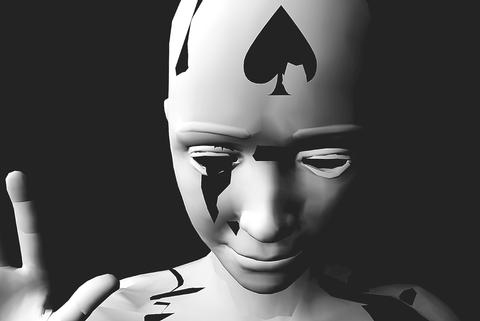The students in Shihchien University's visual communications department wanted to do something for their graduation exhibition that would set them apart from the many other such shows currently going on around town. To do so, they simply dropped any allusion to their school in their promotional materials. Despite this, it's still a show by graduating students and displays many of the weaknesses and strengths one would expect in student works.
The exhibition, called 20 Sicknesses
Foremost among the difficulties faced by artists making 3-D computer animation is achieving natural textures and movement. In this regard, some of the students represented in the exhibition have mastered the technique better than others.

PHOTOS COURTESY OF TIVAC
Chang Kunyi's
Chang's film is among the longer of those on exhibit and strings together a loose narrative about an ant-like figure breaking from the ranks and running toward freedom.
A curiously large number of the films touch on the subjects of technology and progress, almost as if the artists are commenting on the medium they are using to create their works. This is especially evident in Mechanization by Liang Hsuan-wei
At the other end of the spectrum thematically, Yang Dong-qiao (楊東樵) tells a story about a discarded, deflated basketball thrown into a closet. The other sport balls in the closet join forces to pump up the basketball overnight with the predictable ending of the ball's owner opening the closet to find a newly inflated basketball. The short film will remind viewers of Toy Story and not just because the story is a bit similar, but because the animation is just as good, if not better.
Because of their themes and animation the works have an undeniable "techy" feel to them. The one exception to this rule is Chuang Ching-fu's
No matter what angle or style of animation the students chose, however, they expressed an impressive amount of creative ability in a medium that is still evolving and that those long in the field are still developing.

In the March 9 edition of the Taipei Times a piece by Ninon Godefroy ran with the headine “The quiet, gentle rhythm of Taiwan.” It started with the line “Taiwan is a small, humble place. There is no Eiffel Tower, no pyramids — no singular attraction that draws the world’s attention.” I laughed out loud at that. This was out of no disrespect for the author or the piece, which made some interesting analogies and good points about how both Din Tai Fung’s and Taiwan Semiconductor Manufacturing Co’s (TSMC, 台積電) meticulous attention to detail and quality are not quite up to

April 21 to April 27 Hsieh Er’s (謝娥) political fortunes were rising fast after she got out of jail and joined the Chinese Nationalist Party (KMT) in December 1945. Not only did she hold key positions in various committees, she was elected the only woman on the Taipei City Council and headed to Nanjing in 1946 as the sole Taiwanese female representative to the National Constituent Assembly. With the support of first lady Soong May-ling (宋美齡), she started the Taipei Women’s Association and Taiwan Provincial Women’s Association, where she

Chinese Nationalist Party (KMT) Chairman Eric Chu (朱立倫) hatched a bold plan to charge forward and seize the initiative when he held a protest in front of the Taipei City Prosecutors’ Office. Though risky, because illegal, its success would help tackle at least six problems facing both himself and the KMT. What he did not see coming was Taipei Mayor Chiang Wan-an (將萬安) tripping him up out of the gate. In spite of Chu being the most consequential and successful KMT chairman since the early 2010s — arguably saving the party from financial ruin and restoring its electoral viability —

It is one of the more remarkable facts of Taiwan history that it was never occupied or claimed by any of the numerous kingdoms of southern China — Han or otherwise — that lay just across the water from it. None of their brilliant ministers ever discovered that Taiwan was a “core interest” of the state whose annexation was “inevitable.” As Paul Kua notes in an excellent monograph laying out how the Portuguese gave Taiwan the name “Formosa,” the first Europeans to express an interest in occupying Taiwan were the Spanish. Tonio Andrade in his seminal work, How Taiwan Became Chinese,